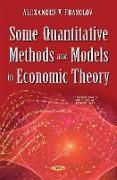- Start
- Some Quantitative Methods & Models in Economic Theory
Some Quantitative Methods & Models in Economic Theory
Angebote / Angebote:
This book takes an intermediate place between monographs and textbooks: on the one hand, it contains known, yet unusually portrayed facts, and on the other hand, the author brings his own results corresponding to the field of research. It is already obvious from the title that while reading the book, attention and concentration are required, as it is always necessary when studying books with mathematical content. Mathematical models and methods in the economic theory are very various. They are as follows: econometrics, the game theory, operation research, nonlinear and chaotic dynamics and many other aspects as well. The book will be interesting only to those who are already familiar with corresponding tasks as well as to students at all levels specializing in economic dynamics, in decision-making methods, in forecasting effects of management and in the analysis of interaction of economic agents. In terms of the most interesting and new models of economic dynamics, the authors emphasize multidimensional nonlinear systems of the differential equations of Lotka-Volterra type. These models have been constructed and analyzed, and scopes of their application and various methods of coefficients identification have been offered for them. The analysis of the competition between various economic agents (i.e. branches of economy, rival companies and sellers in the market) has been made. Another fact unusual to similar monographs is the inclusion of the theory of differential equations with the retarded argument. In economic theory, there are numerous examples of models being used with discrete time (they also have been given attention here) and with time lags (concentrated or distributed). Such an approach gives more adequate models without lags, but in the differential equations with continuous time, the introduction of delay complicates systems while the growth of delay the qualitative behavior of trajectories is changed. Additionally, there appear fluctuations such as stability being changed by instability, etc. As the author has belonged to the St. Petersburg Mathematical School for more than thirty-five years, the list of references contains many Russian names which may be unknown to Western readers. However, the list also includes world classical scientists who devoted their works to mathematical methods in economics. In this monograph, an attentive reader will find numerous points for further analysis which can become a subject of publications or theses. In some cases, the text is conducted in a polemic manner that is, the author is always open for discussions and does not consider his work to be "the ultimate truth".
Folgt in ca. 15 Arbeitstagen
